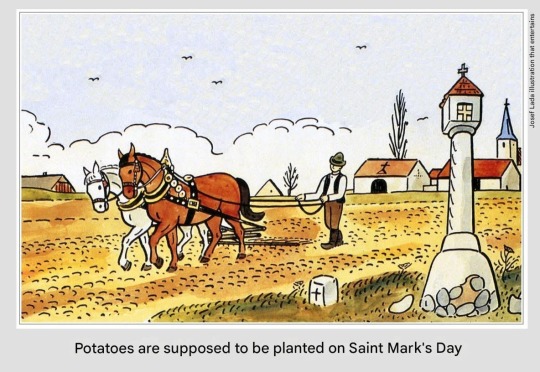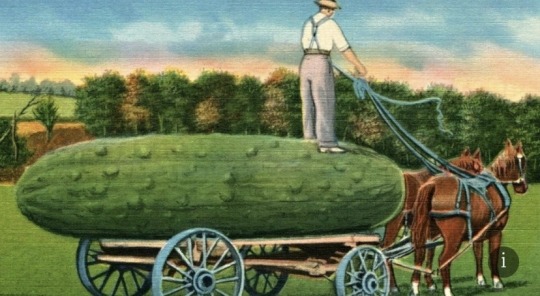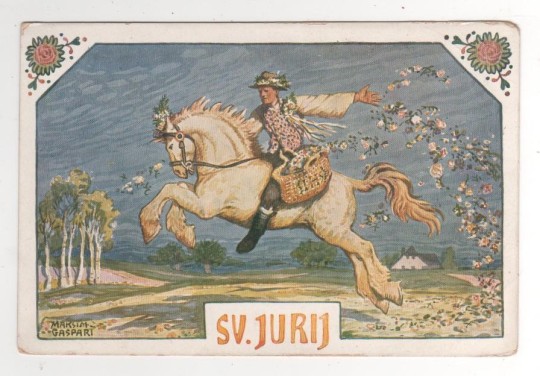Dual faith folk Christian/Western Slavic pagan (Czech/Moravian) mixed with Gaelic and Anglo folk practices/calendar customs to work with ancestors from both sides of the family. My views and practices are those of a reconstructionist North American descendant, not a member of these cultures. Devotional and folk embroidery (largely influenced by Slavic and Baltic tradition). And music. . . lots of posts about music, and Dallas Stars hockey, and food. Mostly original posts. #devotional embroidery #folk embroidery #czech #music #hockey #food #recipes#arkansas river valley #ozark foothills
Last active 60 minutes ago
Don't wanna be here? Send us removal request.
Text

0 notes
Text
Svatý Marek (Saint Mark) Day Brunch

This morning for brunch I wanted to use some of my Kraslice (Easter eggs) before I used the egg shells in a ritual this afternoon. I decided to dig through a cookbook I found a month or so back.


It is a joint project between museums in Austria and Czechia to collect recipes from 1750 to 1918 (my great-grandparents left in 1912—a part of the Slavic diaspora that was getting out before WWI) that were going back and forth across the borders as Czech and Moravian domestic workers went back and forth—introducing Czech folk recipes into Austria and Austrian recipes back home to southern Bohemia and Zjnomo (in southern Moravia where my great grandparents were from). Today’s recipe is from Ivančice—about 30 km from my great-grandparents village.

The first step was to peel and halve the eggs and make a filling. Of course, these old recipes so often do not give proper quantities! I decided to use four eggs. I melted 3 TB of butter and whipped the egg yolks into it and added 2 TB of cream and salt and pepper. The recipe said to mix in egg yolks too, but I didn’t want to waste an egg white and decided after taste testing that it was fine without it.


I then filled the eggs and scrambled one more fresh egg and poured it over. The recipe said to push the two halves back together into a whole egg, but further down it said you could also do it in a layer of halves. When I tried to stick them back together it didn’t work very well so I decided to leave them as halves.
I then sprinkled over a layer of bread crumbs and put the eggs in the oven at 350°F for 10 minutes.



Instead of making the ragout in the recipe with mushrooms, green peas, and asparagus I decided to use the leftover houbová omáčka (mushroom sauce) from the řízek I made on Svatý Jiří (St. George) Eve and use some freshly foraged greens in place of the asparagus and peas. After washing and soaking some lyre leaf sage leaves in a vinegar/water bath, I chopped them and sautéed them, and added them to the houbová omáčka—which I poured over the baked eggs when I took them out of the oven.

It was 👩🏻🍳💋.
#Czech cuisine#historic recipe#Zjnomo#Moravia#baked eggs#Easter eggs#Kraslice#foraging#Ozark foothills#lyre leaf sage#mushroom sauce#Czechia#Austria#historic cookbook#vintage corningware#heritage recipe
6 notes
·
View notes
Text

The peasants considered St. Mark to be one of the lords of the weather, so on this day a procession was held into the countryside with the blessing of young grain (winter grain) and prayers for the harvest. People stopped not only at all the chapels, but also at every crossroads. It is possible that this tradition originated from the ancient Roman festival of Robigalia, the purpose of which was to drive away the spirit of mold that attacked the grain at this time.
Young engaged couples had to be careful not to announce their future marriage on the Sunday preceding the procession. This brought bad luck to their marriage, as did their wedding the week after that Sunday.
St. Mark is also mentioned as a protector against lightning and hail. The reasons for this are told in a legend from the early 1st century: During a service in Alexandria, at Easter, Mark was attacked by a crowd of pagans, who threw a rope around his neck and dragged him through the streets along bumpy roads until he died. The legend goes on to say that when he died, a hailstorm came and only thanks to it did the believers manage to carry away Mark's body and bury it with dignity.
In Moravia they used to say:

"On St. Mark's Day, sow cucumbers in the spring." But this only applies to drier and warmer areas. Elsewhere, it is certainly worth waiting until May and sowing after the frosts, i.e. in the second half of the month. Another wise proverb refers to May 19th: "On Peter Celestine, cucumbers can already be planted outside."
Most of the mentioned pranostics concern the harvest and its sowing. However, some pranostics still concern the possible winter. This is most often manifested by occasional snow or mixed showers in higher altitudes, rain in the lowlands and often the occurrence of frost: "If George warms, then Mark burns. After the pleasant George comes Mark, who often scares us with frost. There are still twelve frosts after Saint George. Saint Mark knocks off the heads of morels (spring mushrooms). After the warm Mark, it often gets cold." The last pranostics says that if it rains on this day, it will rain for two more months: Saint Mark rainy - seven weeks muddy.
Other pranostics say:
Before the twenty-fifth, the croaking of a frog beckons unpleasant weather.
Plant potatoes on St. Mark's Day - there will be a hole full of them.
A row full of potatoes on St. Mark's Day.
Potatoes are to be planted on St. Mark's Day.
On St. Mark's Day, whoever has no bread should bite an apple.
On St. Mark's Day, the spring is green.
On St. Mark's Day, the winter is already great.
As much heat before St. Mark's Day, as much winter after it.
After the warm St. Mark's Day, it often gets cold.
In Zjnomo:
On St. Mark's Day (April 25), Czech and German villages also held prayer processions into the fields. However, the local Germans always took money with them. It was said that if they heard the cuckoo's call and shook the money they had prepared, their wealth would remain with them for the whole year.
13 notes
·
View notes
Text

6 notes
·
View notes
Text
Fertility goddess and god
9 notes
·
View notes
Text
Svaty Jiří/St. George’s Day Walk
A four-leaf clover for grace,
five for children, six for happiness, seven for death.

Star of Bethlehem (though my favorite common names include: dove’s dung and sleepydick)

False dandelion

New redbud seed pods.


Lyre leaf sage
And last but not least yellow clover—clover was what I was looking for, but unfortunately none with more than three leaves. 😉


#czech folklore#Moravian folklore#Ozark foothills#lyre leaf sage#redbud#st. George’s day#Svaty jiří#Jarilo#star of Bethlehem#yellow clover#false dandelion#mushroom
2 notes
·
View notes
Photo

Slovenian post card depicting st. George as folk tradition understands him. He is bringer of spring and blooming flowers, substituting for fertility deity Jarilo. Author: Maksim Gaspari
737 notes
·
View notes
Text

Jarilo on the feast day of Svaty Jiří/St. George
14 notes
·
View notes
Text

St. George / Designer & engraver: Bedřich Housa / Year: 1972


St George With Dragon Czechoslovakia Postage Stamp Souvenir Sheet Issued 1946


3 notes
·
View notes
Text
youtube
Asonance
Pomáhej nám svatý Jiří
English Translation:
Behind the village, near the stream,
in the way the wayside shrine stands.
Nobody will believe me.
In front of altar candles burn,
it's the feast of Saint George.
And the way uphill,
beautiful Anna walked on it.
Nobody will believe me.
Chase away, Saint George, evil powers from our doors.
Where, Anna, where are you rushing?
Why are you scared of everything?
Nobody will believe me.
Chase away, Saint George, evil powers from our doors.
And I rush into the forest,
to tear some clover there.
Nobody will believe me.
Chase away, Saint George, evil powers from our doors.
She gave birth to a child in the forest,
and under the black dirt she buried it.
Nobody will believe me.
Chase away, Saint George, evil powers from our doors.
When she's getting close to the shrine,
strange fear burdens the soul.
Nobody will believe me.
Chase away, Saint George, evil powers from our doors.
The sunset burns with red blood,
and from the cross a voice talks:
Nobody will believe me.
Chase away, Saint George, evil powers from our doors.
"What have you done, Anna?
You have killed your child!"
Nobody will believe me.
Chase away, Saint George, evil powers from our doors.
She runs like crazy on the hillside,
bloody from the hawthorn.
Nobody will believe me.
Chase away, Saint George, evil powers from our doors.
Where the old mill used to stand someday,
there Anna hangs from the beam.
Nobody will believe me.
Chase away, Saint George, evil powers from our doors.
7 notes
·
View notes
Text


Chase away, Saint George, evil powers from our doors.
Honoring both Svaty Jíři (Saint George) and Jarilo
#Saint George’s day#Svaty jíři#Jarilo#resurrection#vegetation god#summer#fertility god#folk embroidery#devotional embroidery#Czech#slavic#snake#altar
7 notes
·
View notes
Text
Celebrating St. George’s Eve (Czech Date) with Pork

I tend to use pork in my ritual and celebratory meals—especially when dealing with resurrection. Maybe because of Sæhrímnir, or maybe it’s just my love of Terry Pratchett’s Hogfather!



I used my resurrection salt (my tongue in cheek description of the salt I consecrated at the creek on Easter) to celebrate/coax/aid and abet my resurrected god of choice, Jarilo, in our St. George’s Eve dinner.

Besides řízek, I made houbová omáčka, because that’s my number one side dish with řízek, but also for the mushroom symbolism of life emerging from darkness—and you know, penis stuff because fertility god!
I also made potatoes because that’s my number two side dish with řízek, but also because of @msgraveyarddirt . Because of her I will always associate potatoes with Svaty Jíři.
#Svaty Jíři#Saint George#Jarilo#vegetation god#resurrection#consort#morana#pig#pork#suidae#ritual meal#řízek#mushroom#potatoes
5 notes
·
View notes
Text
St. George’s Day in the Czech Lands (April 24th)

Josef Lada, Svatý Jiří s drakem
April 23rd is celebrated as St. George’s Day by most of the world but not in the Czech Republic and a couple of other counties. Czechs celebrate it on the 24th. Exceptionally in the Czech Republic, Hungary and Slovakia, Saint George's Day comes on 24 April, because St. Adabert (Svatý Vojtěch) of Prague was martyred on 23 April (997) and the 23rd was set aside for him.
—Nebraska Bohemians Facebook Group
According to one of the St. George superstitions, one should not work in the field, garden, or orchard on this day, because the earth is awakening and people must not disturb it.
It was said that George was heading towards summer or that Saint George had defeated the sleigh and would also defeat winter. According to folk belief, it was believed that on his day the earth opened up and snakes and scorpions would crawl out of their holes, for whom warmth was vital, it would get their blood flowing and give them strength after a long winter sleep. On this day, snakes are not poisonous.

Josef Lada
Snakes obtained on St. George's Day were attributed many magical and healing effects. In some places, snake meat pickled in alcohol or dried was used to treat toothache, ulcers or chills. It was said that whoever tasted a snake caught on St. George's Day would gain the ability to understand animal language.
On St. George's Day, on the other hand, there is poisonous water in wells and springs. It was said that on April 24th, one should not drink water at all because it is poisoned after the winter and the poison in it comes from snakes – so people willingly drank only beer and other alcoholic beverages! However, the poisonousness of the water passed back to the snakes during the day and the next day everything was as it should be – the water was clean and the snakes were poisonous.
On the other hand, people, especially young people, were supposed to bathe outdoors for the first time in the year on St. George's Day, because a spring bath in a stream, river or pond guaranteed strength and health.
And that is why the greatest joy from the arrival of St. George was felt by children, who would chant in high voices on this day:
Saint George rises, unlocks the earth so that grass can grow,
green grass, red roses, blue violets,
all kinds of flowers weave into wreaths.
On St. George's Day, our great-grandmothers looked for magic four-leaf clovers:
It was believed that this symbol of luck was even stronger on April 24 than on other days, had magical powers and would fulfill absolutely all wishes. It was said about the magic clover:
A four-leaf clover for grace,
five for children, six for happiness, seven for death.
A four-leaf clover, found by chance on St. George's Day and sewn into a blouse or shirt, guarantees the wearer faith, hope, love, happiness and protection for the entire following year. When an unmarried girl placed a found or gifted four-leaf clover under her pillow on St. George's Day, her future husband appeared to her in a dream.
In some regions, such as Šumava, April 24th is the day when the first grazing was done. It is also based on the legend: "On St. George's Day, not even four will trample the grass" . It was also important that St. George was considered the protector of horses and cattle. Another reason why this holiday could be associated with the beginning of the vegetation period was the interpretation of the meaning of the name George. We know that it is of Greek origin and literally means farmer or peasant.
On this day, a common drive was held in most villages, which meant that the farmers took their cattle out to the village square for the first time after the winter, where they were usually handed over to the local shepherd. On this occasion, their records were also kept, with each farmer counting the number of animals in his small herd (usually only one or two cows, a calf and a few sheep with lambs). Since the common people did not have parchments and later even expensive paper on which to record the numbers, a simple system of rabuši was used, which were wooden sticks with notches. Two were always placed together and the number of animals was "written down" with a knife. The farmer kept one for checking and the shepherd kept the other. In the autumn, the rabuši were then compared and it was calculated whether the shepherd returned everything as it should be.
In the Zjnomo region:
On the feast day of St. George (April 24), rounds of the cadastral (Cadastral" refers to official records, surveys, or maps that document the boundaries, ownership, and value of land, primarily used for taxation and land management) boundaries were usually held with the participation of the village leaders, during which the boundary markers were checked and whitewashed. In addition, young farmers or boys were paid for each of them so that they would remember well where the boundary markers were located. The round ended with a meeting in the local inn.
In Lesonice, after the round, people would go around the houses with a basket to collect eggs. On this day, or on St. Mark's Day (April 25), they also went around the boundaries of the cadastral boundaries in German villages.
In the evening, they drunk at the boundary markers and the necessary sausages were prepared with the beer. The custom did not differ from the Czech one and was maintained in some villages until the beginning of the 20th century.
Sources:
11 notes
·
View notes
Text
Midwinter/Koleda/Yule and Pork
"In Eldrhimnir Andrhrimnir cooks. Sæhrimnir's seething flesh,— The best of food . . .”
—Poetic Edda, translated by Henry Adams Bellows
We eat a lot of pork during the midwinter/Koleda/Yule period.
In many cultures pork was eaten on New Year’s Day because the pig “digs forward” with its snout, which symbolized progress.
In Indo-European religions, the pig is generally dedicated to the sun and associated with its birth, an example is the Roman Saturn, who during the Saturnalia was supposed to arrive in a chariot pulled by a pig with golden bristles. The golden pig is the sacred animal of Dažbog Svarožic (a Slavic sun god). Freya also owns the golden-bristled boar Hildisvín.

Carnitas: Braised, Fried and Roasted Pork
“When you knuckle down to the depths of Winter, there’s usually a pig in the story. Pigs were especially sacred to the Celts, who believed that they were given as a gift from the Otherworld. The Welsh poet and seer Merlin left a poem behind in which he addresses his oracular sayings to a pig, while in the medieval Welsh story of the smith god, Gofannon’ Feast, we hear of a pig that is eaten but never consumed and who comes to life again so long as the bones are not eaten. This a a common theme throughout the world and is sometimes ritually recreated. In eighteenth-century Lapland, Danish misssionaries were told that the bones of sacrificed animals must be carefully gathered and arranged so that the god to whom they were offered could restore life to the animals, making them fatter than before. Such rituals were performed so that the deity might provide more animals of the same kind in due course.” —John Matthews, The Winter Solstice
In Norse mythology, Sæhrímnir is a boar that is killed and eaten by the Æsir and einherjar every night. The cook of the gods, Andhrímnir, prepares Sæhrímnir in the cauldron Eldhrímnir. After Sæhrímnir is eaten, the beast is brought back to life again to provide sustenance for the following day.
In Czech folklore it is said that if you fast all day on Christmas Eve you will be gifted with a vision of the golden pig. For in the pre-Christian past pagans were attracted by the vision of a golden pig for good luck. Gold signaled the beginning of the departure of winter, while the pig promised abundance and prosperity.

Terry Pratchett got it:

Hogfather (2006), directed by Vadim Jean and written by Vadim Jean and Terry Pratchett
It seems reasonable to end the midwinter/Koleda/Yule holiday with a pork dish.
We started off with pork tamales for Christmas Day and continued with Moravian sparrows and hubník for New Year’s Day and now for tonight and Twelfth Night I’m making carnitas.
(Our holiday cooking features most prominently Czech and Czech-American and Tex-Mex foods to honor my Nebraskan-Czech ancestry and his Anglo-Texan.)





I used Roberto Santibañez’s recipe from his cookbook Truly Mexican—one of my all time favorite cookbooks.
I also made a simple restaurant style salsa to go with it.

Read more about folk customs and pigs:
21 notes
·
View notes
Video
youtube
Ярило, вставай рано, яр-яр вставай рано; Ярило, мыйся бело, яр-яр мыйся бело; Ярило, езди в поле, яр-яр езди в поле; Ярило, возьми ключи, яр-яр возьми ключи; Ярило, отмкни Землю, яр-яр отмкни Землю; Ярило, пусти траву, яр-яр пусти траву; Ярило, зеленую, яр-яр зеленую; Ярило, пусти росу, яр-яр пусти росу; Ярило, пусти росу, яр-яр пусти росу; Ярило, медвяную, яр-яр медвяную; Ярило, дай нам долю, яр-яр дай нам долю; Ярило, счастливую, яр-яр счастливую. ————————- Yarilo, wake up early, Yar-Yar wake up early; Yarilo, bathe yourself white, Yar-Yar bathe yourself white; Yarilo, ride in the field, Yar-Yar ride in the field; Yarilo, take the keys, Yar-Yar take the keys;
Yarilo, unlock the Earth, Yar-Yar unlock the Earth; Yarilo, release the grass, Yar-Yar release the grass; Yarilo, the green grass, Yar-Yar the green grass; Yarilo, release the dew, Yar-Yar release the dew;
Yarilo, release the dew, Yar-Yar release the dew; Yarilo, the honey-like dew, Yar-Yar the honey-like dew; Yarilo, bestow our fate, Yar-Yar bestow our fate; Yarilo, fortunate fate, Yar-Yar fortunate fate .
31 notes
·
View notes
Text

#dallas stars#hockey#nhl#stanley cup playoffs#seggy#Tyler seguin#Mason marchment assist#ot goal#mush#mason marchment#dusegment
9 notes
·
View notes
Text
Saint Vojtěch (Adalbert) Day

Adalbert is the patron saint of the Czech Republic, Poland, and the Duchy of Prussia. He is also the patron saint of the Archdiocese of Esztergom in Hungary.
Adalbert of Prague, known in the Czech Republic, Poland and Slovakia by his birth name Vojtěch was a Czech missionary and Christian saint. He was the Bishop of Prague and a missionary to the Hungarians, Poles, and Prussians, who was martyred in his efforts to convert the Baltic Prussians to Christianity. He is said to be the composer of the oldest Czech hymn Hospodine, pomiluj ny and Bogurodzica, the oldest known Polish anthem but his authorship of them has not been confirmed.
While the rest of the Christian world is celebrating St. George’s Day in Czechia, Hungary and Slovakia it is St. Vojtěch Day (they celebrate St. Georgescu a day later).
On Svaty Vojtěch Day girls would go to the forest to catch a young wild pigeon. Since this task was not easy, the girls preferred to buy these young pigeons from gamekeepers or woodsmen.
Folk customs associated with the feast of St. Adalbert (Svatý Vojtěch) are probably not very old and are not very widespread. They were associated with pigeon breeding. Young girls wanted to get the beloved of their dreams by means of magical rituals with pigeons, and pigeon fanciers tried to attract foreign pigeons to their pigeon lofts through various practices.
On the eve of St. Adalbert's Day, girls would go to the forest to catch a young wild pigeon, as they said that doves were unsuitable. Since this task was not easy, the girls preferred to buy these young ones from gamekeepers or woodworkers. When the lucky girl finally managed to get a young pigeon that could not yet fly, she would take it home secretly so that no one would know about it. In her room, the girl would put the pigeon under a sieve or in a box, where she would carefully care for and feed it. This continued until the pigeon could fly. Then early in the morning, while everyone was still sleeping in the house, the girl would go with it to the "black kitchen" under the chimney. Here she cuddled the dove one last time, holding it to her breasts with her right hand, and with her left, which held the sleeve of her shirt, she made three circles in the air and threw the dove high up, whereupon it flew up the chimney and away. During this "enchantment" the girl said:
Fly away, little dove, out the chimney!
Just take me, little Hansel, just take me.
Fly away, little dove, to your rock!
How can I get you, little Hansel!
If no one saw anything that happened under the chimney and if no one met the enchantress, the girl in love achieved what her heart longed for. The spell had a powerful effect on her lover, who would not leave her under any circumstances, and the relationship ended safely in marriage.
Svatý Vojtěch and Whipcracking
A local shepherd, who was herding sheep, wanted to play a prank on the sleeping saint and blew a horn into his ear. For his rash act, he went deaf on the spot.
In earlier times, when the local shepherds drove their flocks out to pasture in the morning, they would blow a horn so that the housewives would open the gates of the farms and drive the cattle out to the village square, from where the shepherd would then drive them to the local pasture. In the pretty village of Milavče in the Domažlice region, it was also customary for the shepherd to blow a horn loudly every morning. Later, however, instead of blowing a horn, they began to crack a whip loudly, although the shepherd's horn was the pride of the local shepherd everywhere. Why did this happen?
According to legend, St. Adalbert was returning from his stay in Rome through this region in 992. It was in the area of today's village of Milavče (located less than 6 km from Domažlice) that the saint was caught up by messengers who told him the sad news about the murder of all his relatives on Libica. The devastated Adalbert decided to take a short rest. His companions went to get water and he fell asleep. A local shepherd, who was herding sheep, wanted to play a joke on the sleeping saint and blew a horn in his ear. He went deaf on the spot for his rash act.
On the way, where Adalbert was resting, a spring suddenly gushed out, which, according to some, foretold health, according to others, healed and healed. Allegedly, from that time on, the shepherds of Milava did not blow horns, but only cracked whips. This custom was carefully observed even in the last century. A wooden building was later built above the spring, which was later replaced by a chapel.
7 notes
·
View notes